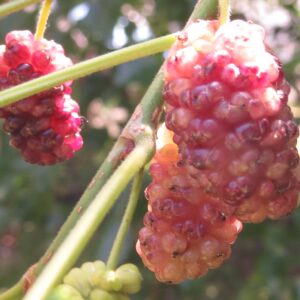Mulberries
Juciy
Mulberries are juicy fruits bursting with sweet, succulent flavor, making them a delightful treat to enjoy fresh or in jams and desserts.
Elongated
Mulberries typically have an elongated shape, resembling a miniature version of a blackberry or raspberry, with a slightly tapered tip.
Nutritious
Mulberries are packed with nutrients, including vitamins C and K, iron, potassium, and dietary fiber, making them a healthy addition to any diet.
Shade-providing
Mulberries are packed with nutrients, including vitamins C and K, iron, potassium, and dietary fiber, making them a healthy addition to any diet.
FAQ
-
What does a mulberry taste like?
-
Mulberry fruit can vary slightly depending on its ripeness, but it generally offers a delightful and complex combination of sweet, tart, and juicy elements. Ripe mulberries are predominantly sweet, with a milder, delicate flavor reminiscent of blackberry, raspberry and strawberry. Though its sweetness is often described as honeyed or syrupy, some varieties also have an enjoyably subtle tang. The fruit’s combination of sweetness and subtle tartness, along with its juicy, meatier-than-other-berries texture, makes it a refreshing and versatile early summer treat.
-
-
How do you eat a mulberry?
- Mulberries can be treated like any other bush berry (i.e. strawberry, blackberry, raspberry, etc.). Note: The small green stems are edible and, generally, undetectable. They are wonderful fresh, going directly from tree to mouth but can also be processed into many things including all kinds of baked goods, jams and jellies, smoothies and juice, syrups and sauces, wine or dried and added to granola and trail mix.
-
Where can I find mulberry?
-
Mulberry trees are widely distributed across the United States and can be found in various natural, urban, and cultivated settings, especially those where the land has been disturbed or along tree lines and fence rows. In the Eastern US, the native, and therefore, most common type is the Red Mulberry (Morus rubra). All throughout the country, it is common to find the White Mulberry (Morus alba) as it has naturalized since being introduce from Asia to North America in the early 1600s for silk production. Black Mulberry (Morus nigra) is only cultivated in warmer climates like California, Arizona, and New Mexico. Note: The Latin names do not indicate anything about the fruit color. As with pawpaw and persimmon, it is difficult to find mulberries in most retail or farmer’s market scenarios. The best way to eat a mulberry is to either grow a named cultivar yourself or wild forage, which is a reasonable endeavor though you may only find low quality fruit and will have to beat the birds to it!
-
Growing Tips for Success
Mulberries Grow Great Here!

%







